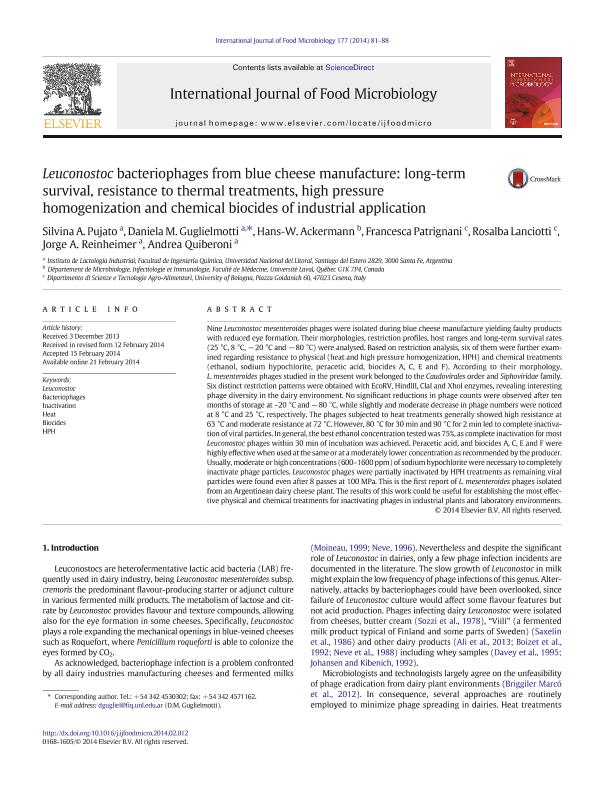Artículo
Leuconostoc bacteriophages from blue cheese manufacture: Long-term survival, resistance to thermal treatments, high pressure homogenization and chemical biocides of industrial application
Pujato, Silvina ; Guglielmotti, Daniela Marta
; Guglielmotti, Daniela Marta ; Ackerman, Hans W.; Patrignani, Francesca; Lanciotti, Rosalba; Reinheimer, Jorge Alberto
; Ackerman, Hans W.; Patrignani, Francesca; Lanciotti, Rosalba; Reinheimer, Jorge Alberto ; Quiberoni, Andrea del Lujan
; Quiberoni, Andrea del Lujan
 ; Guglielmotti, Daniela Marta
; Guglielmotti, Daniela Marta ; Ackerman, Hans W.; Patrignani, Francesca; Lanciotti, Rosalba; Reinheimer, Jorge Alberto
; Ackerman, Hans W.; Patrignani, Francesca; Lanciotti, Rosalba; Reinheimer, Jorge Alberto ; Quiberoni, Andrea del Lujan
; Quiberoni, Andrea del Lujan
Fecha de publicación:
21/02/2014
Editorial:
Elsevier Science
Revista:
International Journal Of Food Microbiology
ISSN:
0168-1605
Idioma:
Inglés
Tipo de recurso:
Artículo publicado
Clasificación temática:
Resumen
Nine Leuconostoc mesenteroides phages were isolated during blue cheese manufacture yielding faulty products with reduced eye formation. Their morphologies, restriction profiles, host ranges and long-term survival rates (25ºC, 8ºC, -20ºC and -80ºC) were analyzed. Based on restriction analysis, six of them were further examined regarding resistance to physical (heat and high pressure homogenization, HPH) and chemical treatments (ethanol, sodium hypochlorite, peracetic acid, biocides A, C, E and F). According to their morphology, Ln. mesenteroides phages studied in the present work belonged to Caudovirales order and Siphoviridae family. Six distinct restriction patterns were obtained with EcoRV, HindIII, ClaI and XhoI enzymes, revealing interesting phage diversity in the dairy environment. No significant reductions in phage counts were observed after ten months of storage at -20ºC and -80ºC, while slightly and moderate decrease in phage numbers were noticed at 8ºC and 25ºC, respectively. Phages subjected to heat treatments generally showed high resistance at 63ºC and moderate resistance at 72ºC. However, 80ºC for 30 min and 90ºC for 2 min led to complete inactivation of viral particles. In general, the best ethanol concentration tested was 75%, as complete inactivation for most Leuconostoc phages within 30 min of incubation was achieved. Peracetic acid, biocides A, C, E and F were highly effective when used at the same or at a moderately lower concentration as recommended by the producer. Usually, moderate or high concentrations (600-1600 ppm) of sodium hypochlorite were necessary to completely inactivate phage particles. Leuconostoc phages were partially inactivated by HPH treatments as remaining viral particles were found even after 8 passes at 100 MPa. This is the first report of Ln. mesenteroides phages isolated from an Argentinean dairy cheese plant. Results of this work could be useful for establishing the most effective physical and chemical treatments for inactivating phages in industrial plants and laboratory environments
Palabras clave:
Leuconostoc
,
Bacteriophages
,
Inactivation
,
Heat
,
Biocides
,
Hph
Archivos asociados
Licencia
Identificadores
Colecciones
Articulos(INLAIN)
Articulos de INST.DE LACTOLOGIA INDUSTRIAL
Articulos de INST.DE LACTOLOGIA INDUSTRIAL
Citación
Pujato, Silvina; Guglielmotti, Daniela Marta; Ackerman, Hans W.; Patrignani, Francesca; Lanciotti, Rosalba; et al.; Leuconostoc bacteriophages from blue cheese manufacture: Long-term survival, resistance to thermal treatments, high pressure homogenization and chemical biocides of industrial application; Elsevier Science; International Journal Of Food Microbiology; 177; 21-2-2014; 81-88
Compartir
Altmétricas



